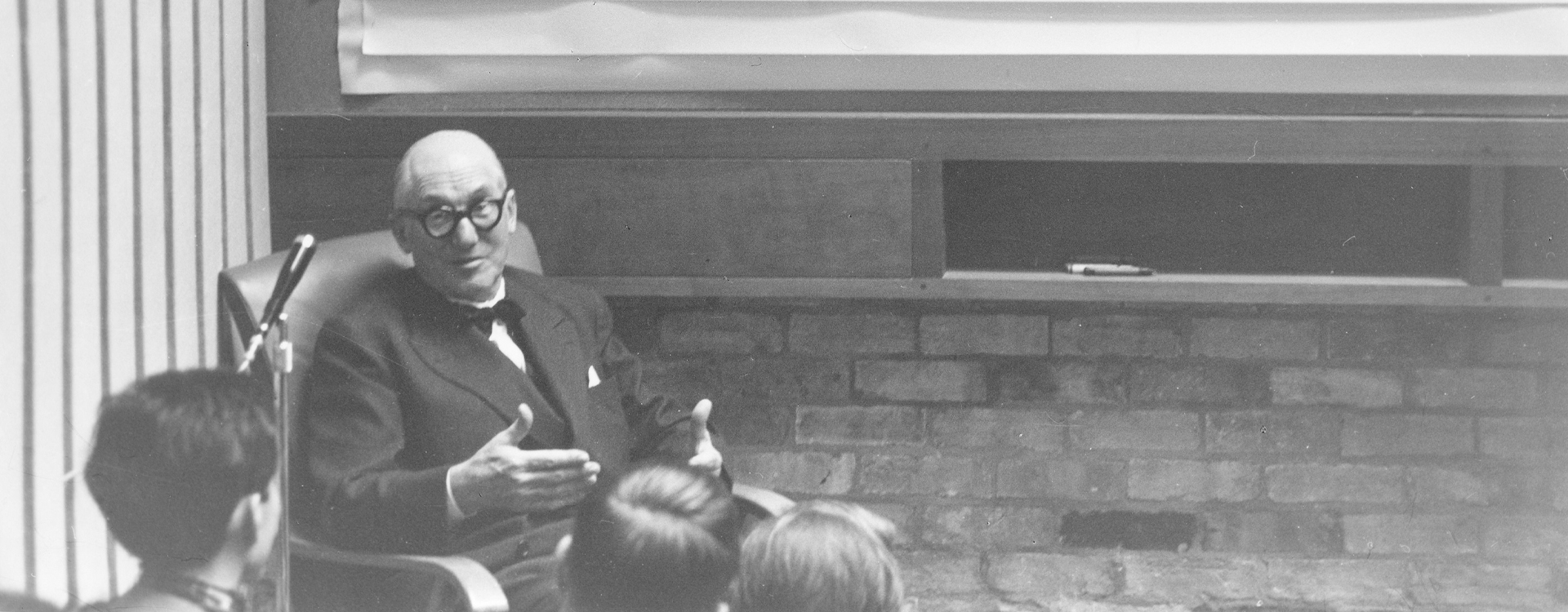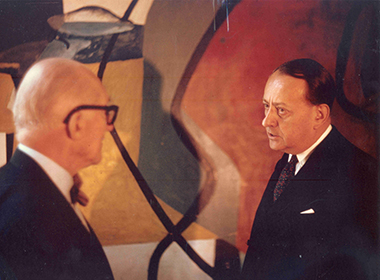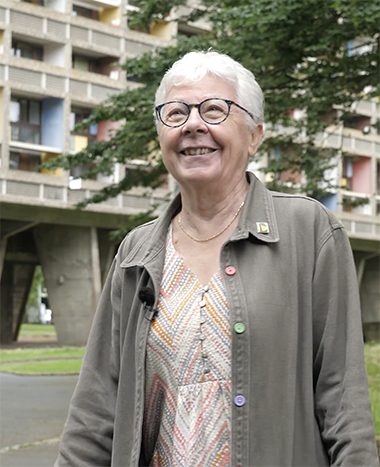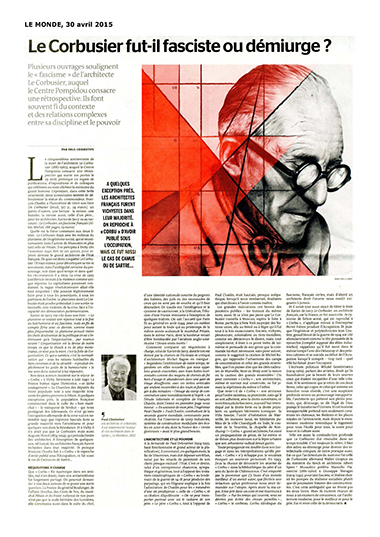
Focus on
Sometimes considered cuckoo, sometimes considered a Bolshevik, Le Corbusier was the subject of numerous controversies during his lifetime, which continue to this day.
The Foundation, which holds the moral rights of Le Corbusier, has always refused to engage in hagiography but wishes to give a full account of the nature of the man and his work.
Nevertheless, it deplores the partisan, deliberately polemical, and non-historical use of statements contained in his private correspondence, which have been deliberately taken out of context. These statements in no way reflect the fully humanistic thinking behind Le Corbusier’s societal, architectural, and urban project.
Given the complexity of the accusations, there are, of course, scientific responses, supported by historians and specialists (as indicated in the bibliography), but we nevertheless offer here some answers to the controversies surrounding Le Corbusier.
To learn more... answers from historians
- RÉMI BAUDOUÏ: historian, urban planner, and political scientist. He holds doctorates from the Paris Institute of Urban Planning and the Paris Institute of Political Studies. An honorary professor at the University of Geneva, he is currently a professor at the University of Grenoble-Alpes. He has worked on the modernization and modernity of France from the 1920s to the present day.
- R.Baudouï et A.Dercelles, « Haro sur le Corbeau… » in R.Baudouï, (dir.) Le Corbusier, 1930-2020 Polémiques, mémoire et histoire, Paris, Taillandier, 2020
- ANTOINE PICON: historian of architecture and technology in the 20th and 21st centuries, director of research at the École nationale des ponts et chaussées and professor at the Graduate School of Design at Harvard University.
- JACQUES SBRIGLIO: architect and urban planner, he heads the sbriglio.architectes agency, which works in the fields of urban planning, architecture, and scenography.
- Article « Le Corbusier et les snipers » dans d’architectures
- RÉMI BAUDOUÏ: historian, urban planner, and political scientist. He holds doctorates from the Paris Institute of Urban Planning and the Paris Institute of Political Studies. An honorary professor at the University of Geneva, he is currently a professor at the University of Grenoble-Alpes. He has worked on the modernization and modernity of France from the 1920s to the present day.
- R.Baudouï et A.Dercelles, « Haro sur le Corbeau… » in R.Baudouï, (dir.) Le Corbusier, 1930-2020 Polémiques, mémoire et histoire, Paris, Taillandier, 2020
- ANTOINE PICON: historian of architecture and technology in the 20th and 21st centuries, director of research at the École nationale des ponts et chaussées and professor at the Graduate School of Design at Harvard University.
- JACQUES SBRIGLIO: architect and urban planner, he heads the sbriglio.architectes agency, which works in the fields of urban planning, architecture, and scenography.
- Article « Le Corbusier et les snipers » dans d’architectures
As a historian who has worked on the engagement of intellectuals, the question of fascism, and the socio-political construction of memory, I propose a brief exercise in elucidating and refuting the new dark dogma surrounding Le Corbusier. The aim is to reveal the biases of the current strategy of denunciation and to propose a counter-argumentative framework. Between the myth and the counter-myth that is emerging, I believe it is useful to reintroduce the controversy into a historical framework that allows for a necessary and salutary distancing. Not to defend Le Corbusier and his memory (I am not one of the “Master’s” admirers), but to defend a certain ethic of criticism.
Robert Belot in Le Corbusier fasciste ? Dénigrement et mésusage de l’histoire, Paris, Hermann, 2021
ROBERT BELOT: Historian specializing in the political and cultural history of France under the Occupation and the socio-political construction of memory.
“The defining characteristic of disqualifying enterprises is the freedom (sometimes license) they grant themselves to ignore the complexity of reality and fail to account for the contradictions it provokes. […] How can one decree that his thinking is anti-humanist when Le Corbusier constantly proclaimed that his ultimate ambition was organized around an “exclusively human program, placing man at the center of architectural concerns” and making housing one of the foundations of human rights?
How can he be accused of organic anti-Semitism when the pre-war far right presented him as the embodiment of “anti-France” because he was supposedly in the service of “foreigners” and “international Jewry”?
Why does the noise surrounding Le Corbusier’s supposed Vichyism (he held no position and received no commissions) contrast so sharply with the silence surrounding his mentor, Auguste Perret, a member of the honorary committee of the Arno Brecker exhibition in 1942, elected to the Academy of Fine Arts in 1943, appreciated by two successive directors of the Beaux-Arts, and an influential member of the Order of Architects (an order founded by Vichy and which was virtually untouched by the “purge” after the Liberation)?
How could someone be “pro-Nazi” and a “collaborator” and yet be celebrated as one of the figures of France’s renewal by a government that emerged from the Resistance?
It is these contradictions that we are tempted to expose and attempt to resolve.
Robert Belot in Le Corbusier fasciste ? Dénigrement et mésusage de l’histoire (Le Corbusier, fascist? Denigration and misuse of history), Paris, Hermann, 2021

“Le Corbusier had great rivals, some of whom we are honored to have here today, while others have passed away. But none of them had such a profound impact on the architectural revolution, because none of them were insulted so patiently for so long.
Glory finds its supreme brilliance through outrage, and this glory was directed more at a work than at a person, who lent himself little to it. After spending so many years working in the wide corridor of a disused convent, the man who designed capitals died in a solitary cabin.”
André Malraux (former ministry of Culture), Funeral oration to Le Corbusier — September 1st, 1965, Cour carrée du Louvre, Paris
Is Le Corbusier the father of public housing and large housing developments?
Among the frequent attacks, one of the most recurrent is that Le Corbusier is the father of public housing, large housing estates, and concrete towers in cities. Beyond a sterile conflation of housing units and large housing estates, there is a profound misunderstanding of Le Corbusier’s project for collective and social housing.
Read more
The Marseille housing unit was built during the post-war reconstruction period, when there was an urgent need to rehouse the population. Designed in late 1945 and completed in 1952, this building, known as the “radiant city,” has features that very few apartment buildings had, even in the 1970s and 1980s: apartments with windows on two sides to allow natural light throughout the day, sound and heat insulation (double glazing), interior streets to facilitate traffic and residents’ lives, a shopping street, a school, a daycare center, and more. The housing unit as designed by Le Corbusier functions as a “vertical village.” Today, some 4,000 people live in these buildings from Marseille to Berlin, and none of them have ever felt like they live in a “rabbit hutch”!
Among the frequent attacks, one of the most recurrent is that Le Corbusier is the father of public housing, large housing estates, and concrete towers in cities. Beyond a sterile conflation of housing units and large housing estates, there is a profound misunderstanding of Le Corbusier’s project for collective and social housing.
The Marseille housing unit was built during the post-war reconstruction period, when there was an urgent need to rehouse the population. Designed in late 1945 and completed in 1952, this building, known as the “radiant city,” has features that very few apartment buildings had, even in the 1970s and 1980s: apartments with windows on two sides to allow natural light throughout the day, sound and heat insulation (double glazing), interior streets to facilitate traffic and residents’ lives, a shopping street, a school, a daycare center, and more. The housing unit as designed by Le Corbusier functions as a “vertical village.” Today, some 4,000 people live in these buildings from Marseille to Berlin, and none of them have ever felt like they live in a “rabbit hutch”!

“But it was an experimental building designed for a different way of living, taking into account poetry, the interplay of space—in other words, harmony, the harmony that weighs on people, that weighs on their happiness. And then there was the freedom of the layout, too, because modern technology gives us that. The openness to light, family life where the kitchen is directly connected to the living room and where you can talk with your family and friends—in short, a very convivial life.”
Charlotte Perriand on the Marseille Housing Unit, Du côté de chez Fred, 1989
Was Le Corbusier a fascist?
“Never involved in politics, but was often accused of communism and fascism, depending on the circumstances.”
Le Corbusier, February 6th, 1941
We could simply dismiss this accusation by pointing to the universalism of his work, his cosmopolitan and multi-faith architecture studio, his friendships, and his immoderate taste for primitive arts, which some considered “degenerate.” However, given the frequency of this attack, we prefer to recall certain facts.
Le Corbusier was never a member of any political party or even any political group. Just as the communists sought to appropriate Le Corbusier’s work (including his City of Radiant Life project), certain fascists appreciated his interest in and thinking about urban planning and housing.
Read more
It is possible to point to Le Corbusier’s rejection of parliamentarianism, even a taste for authoritarianism (common after the 1929 crisis), which should not be confused with fascism, an ideology from which Le Corbusier’s work and thinking were completely separate.
His circle included a large number of humanist figures: Jean Cassou (who co-founded the Comité de vigilance des intellectuels antifascistes), Fernand Léger, Paul Otlet, Jean Zay, Jean Lurçat, Louis Aragon, Pablo Picasso, and Romain Rolland. And even if Le Corbusier was able to attract a few fascist sympathizers, such as Philippe Lamour, who was a member of the Faisceaux but attacked Céline’s anti-Semitism and was a leading member of the Resistance from the outset, it should be emphasized that he never embraced the ideas of fascism.
“Never involved in politics, but was often accused of communism and fascism, depending on the circumstances.”
Le Corbusier, February 6th, 1941
We could simply dismiss this accusation by pointing to the universalism of his work, his cosmopolitan and multi-faith architecture studio, his friendships, and his immoderate taste for primitive arts, which some considered “degenerate.” However, given the frequency of this attack, we prefer to recall certain facts.
Le Corbusier was never a member of any political party or even any political group. Just as the communists sought to appropriate Le Corbusier’s work (including his City of Radiant Life project), certain fascists appreciated his interest in and thinking about urban planning and housing.
It is possible to point to Le Corbusier’s rejection of parliamentarianism, even a taste for authoritarianism (common after the 1929 crisis), which should not be confused with fascism, an ideology from which Le Corbusier’s work and thinking were completely separate.
His circle included a large number of humanist figures: Jean Cassou (who co-founded the Comité de vigilance des intellectuels antifascistes), Fernand Léger, Paul Otlet, Jean Zay, Jean Lurçat, Louis Aragon, Pablo Picasso, and Romain Rolland. And even if Le Corbusier was able to attract a few fascist sympathizers, such as Philippe Lamour, who was a member of the Faisceaux but attacked Céline’s anti-Semitism and was a leading member of the Resistance from the outset, it should be emphasized that he never embraced the ideas of fascism.

“And thanks also to all the young people who were foreigners, who came from all over the world to work for him, because in his company they found not only architecture, but also a vision of the 20th and 21st centuries that went beyond the monument of architecture itself. In other words, a society, a new humanism. And that is Le Corbusier.”
Charlotte Perriand about Le Corbusier, Du côté de chez Fred, 1989
- Jean-Louis Cohen (1949-2023): architect, doctor of art history, and professor of architectural history at the Institute of Fine Arts at New York University
- Tribune dans Le Monde, « Le Corbusier, fasciste ou séducteur ? »
- Paul Chemetov (1928-2024) : architect and urban planner, National Grand Prize for Architecture
- Article dans Le Monde « Le Corbusier, faciste ou démiurge ? »
Le Corbusier and Vichy
“Goodbye, dear bugger Vichy !”
Le Corbusier to Père Bordachar, July 1st, 1942
Le Corbusier went to Vichy, like many French architects, but left before Laval returned to power, and therefore before the French state began actively collaborating with the Nazi regime (the Vel’ d’Hiv roundup, STO, etc.). Considered a communist, he was confined to architectural subcommittees with no real power.
From July 1942 onwards, Le Corbusier began planning for reconstruction (the ASCORAL projects, etc.) in the post-war period and understood that the future lay with General Charles de Gaulle.
Upon liberation, having never collaborated with the enemy, he was approached by communists and former members of the Resistance (Minister Eugène Claudius-Petit, François Le Lionnais, Henri Maux, Jean Prouvé, etc.) to join the Front National des Architectes (FNA), an offshoot of the Front National de Lutte pour la libération et l’Indépendance de la France (National Front for the Liberation and Independence of France). His ideas developed during the Second World War were also taken up by the National Council of the Resistance, and he was called upon to help rebuild France. In 1964, he was awarded the Grand Cross of the Legion of Honor with the support of André Malraux and General De Gaulle.
“Goodbye, dear bugger Vichy !”
Le Corbusier to Père Bordachar, July 1st, 1942
Le Corbusier went to Vichy, like many French architects, but left before Laval returned to power, and therefore before the French state began actively collaborating with the Nazi regime (the Vel’ d’Hiv roundup, STO, etc.). Considered a communist, he was confined to architectural subcommittees with no real power.
From July 1942 onwards, Le Corbusier began planning for reconstruction (the ASCORAL projects, etc.) in the post-war period and understood that the future lay with General Charles de Gaulle.
Upon liberation, having never collaborated with the enemy, he was approached by communists and former members of the Resistance (Minister Eugène Claudius-Petit, François Le Lionnais, Henri Maux, Jean Prouvé, etc.) to join the Front National des Architectes (FNA), an offshoot of the Front National de Lutte pour la libération et l’Indépendance de la France (National Front for the Liberation and Independence of France). His ideas developed during the Second World War were also taken up by the National Council of the Resistance, and he was called upon to help rebuild France. In 1964, he was awarded the Grand Cross of the Legion of Honor with the support of André Malraux and General De Gaulle.
Le Corbusier était-il antisémite ?
“The result, we saw it: the Czech Republic vilified, massacred. Then the Jews treated in ways we would never have dared to imagine.”
Le Corbusier, letter to his mother, November 18th, 1938
In public, Le Corbusier never made any anti-Semitic remarks. On the contrary, his public lectures show that he never discriminated against Jews. His detractors point to a few anti-Semitic remarks contained in his private correspondence from his youth, which the Foundation itself published and made public. It is right to be moved by this vocabulary, which is linked to a historical context, that of European anti-Semitism before the Second World War, in the direct line of the Dreyfus affair.
Read more
It is also important to bear in mind Switzerland’s unique context when it comes to religious practice. Freedom of worship for Jews has only been granted and guaranteed since the 1874 law on religious freedom. It was therefore with the constitutional revisions of 1866 and 1874 that Jews finally obtained the same rights as the Christian Swiss population. With emancipation, Jewish communities, which had previously been mainly rural, settled in cities and gradually participated in the national economic boom. Geneva, Basel, Zurich, La Chaux-de-Fonds, and other cities benefited from the arrival of German Jews from Alsace, who were later joined by Jews from Eastern Europe. On the eve of World War I, the Jewish population numbered only 20,000. But individual social successes sparked waves of anti-Semitism. These developed alongside anti-Marxism, fueled by the decline of the watchmaking industry in La Chaux-de-Fonds. From 1918 to 1945, numerous restrictive policies regarding the reception of immigrant populations came to light. It was recommended that Jews from Eastern Europe no longer be allowed to enter the country.
From the mid-1930s onwards, Le Corbusier welcomed Jewish architects to his studio, including Shlomo Bernstein and Sam Barkai, architects who had taken refuge in British-mandated Palestine. He never discriminated in the recruitment of his colleagues. On the contrary, he made his studio a cosmopolitan and multi-faith place. Many of his clients were Jewish (Schwob, Stein, Lipchitz, Ditisheim, etc.), as were some of his colleagues (Julius Posener, etc.). He also developed many friendships with Jews (Jean Badovici, Lucien and Judith Hervé, Lucien Schwob, Saul Steinberg, Marcel Levaillant, whose friendship lasted from his childhood until his death, etc.). and Anna Gutman, wife of André Gutman, president of the new Jewish circle in La Chaux-de-Fonds (of which Le Corbusier was a member from 1914 to 1917), whom he considered a dear friend. Le Corbusier repeatedly expressed his gratitude to his Jewish clients in La Chaux-de-Fonds.
Aware of the violence against Jewish populations in Europe in the late 1930s, he took action on February 21, 1939. Le Corbusier returned to this issue during a conference for the Jewish association “Notre Cité” in front of the Jewish youth of France. Deeply affected by the Holocaust after 1945, he actively supported the Ligue Française pour la Palestine Libre, a left-wing association campaigning for the creation of a Jewish state. In 1947, he signed his “Appeal to the British People.” He was thanked for this by the association’s president, Henri Dillot.
On the occasion of the 1958 World’s Fair, Le Corbusier expressed his emotion by recalling the tragedy of the extermination camps through his Poème électronique, projected in the heart of the Philips Pavilion.
“The result, we saw it: the Czech Republic vilified, massacred. Then the Jews treated in ways we would never have dared to imagine.”
Le Corbusier, letter to his mother, November 18th, 1938
In public, Le Corbusier never made any anti-Semitic remarks. On the contrary, his public lectures show that he never discriminated against Jews. His detractors point to a few anti-Semitic remarks contained in his private correspondence from his youth, which the Foundation itself published and made public. It is right to be moved by this vocabulary, which is linked to a historical context, that of European anti-Semitism before the Second World War, in the direct line of the Dreyfus affair.
It is also important to bear in mind Switzerland’s unique context when it comes to religious practice. Freedom of worship for Jews has only been granted and guaranteed since the 1874 law on religious freedom. It was therefore with the constitutional revisions of 1866 and 1874 that Jews finally obtained the same rights as the Christian Swiss population. With emancipation, Jewish communities, which had previously been mainly rural, settled in cities and gradually participated in the national economic boom. Geneva, Basel, Zurich, La Chaux-de-Fonds, and other cities benefited from the arrival of German Jews from Alsace, who were later joined by Jews from Eastern Europe. On the eve of World War I, the Jewish population numbered only 20,000. But individual social successes sparked waves of anti-Semitism. These developed alongside anti-Marxism, fueled by the decline of the watchmaking industry in La Chaux-de-Fonds. From 1918 to 1945, numerous restrictive policies regarding the reception of immigrant populations came to light. It was recommended that Jews from Eastern Europe no longer be allowed to enter the country.
From the mid-1930s onwards, Le Corbusier welcomed Jewish architects to his studio, including Shlomo Bernstein and Sam Barkai, architects who had taken refuge in British-mandated Palestine. He never discriminated in the recruitment of his colleagues. On the contrary, he made his studio a cosmopolitan and multi-faith place. Many of his clients were Jewish (Schwob, Stein, Lipchitz, Ditisheim, etc.), as were some of his colleagues (Julius Posener, etc.). He also developed many friendships with Jews (Jean Badovici, Lucien and Judith Hervé, Lucien Schwob, Saul Steinberg, Marcel Levaillant, whose friendship lasted from his childhood until his death, etc.). and Anna Gutman, wife of André Gutman, president of the new Jewish circle in La Chaux-de-Fonds (of which Le Corbusier was a member from 1914 to 1917), whom he considered a dear friend. Le Corbusier repeatedly expressed his gratitude to his Jewish clients in La Chaux-de-Fonds.
Aware of the violence against Jewish populations in Europe in the late 1930s, he took action on February 21, 1939. Le Corbusier returned to this issue during a conference for the Jewish association “Notre Cité” in front of the Jewish youth of France. Deeply affected by the Holocaust after 1945, he actively supported the Ligue Française pour la Palestine Libre, a left-wing association campaigning for the creation of a Jewish state. In 1947, he signed his “Appeal to the British People.” He was thanked for this by the association’s president, Henri Dillot.
On the occasion of the 1958 World’s Fair, Le Corbusier expressed his emotion by recalling the tragedy of the extermination camps through his Poème électronique, projected in the heart of the Philips Pavilion.